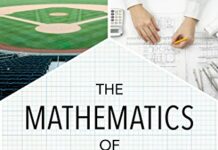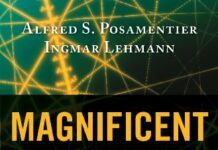
Ebook Info
- Published: 2011
- Number of pages: 368 pages
- Format: PDF
- File Size: 15.28 MB
- Authors: Alfred S. Posamentier
Description
What exactly is the Golden Ratio? How was it discovered? Where is it found? These questions and more are thoroughly explained in this engaging tour of one of mathematics’ most interesting phenomena. The authors trace the appearance of the Golden Ratio throughout history, demonstrate a variety of ingenious techniques used to construct it, and illustrate the many surprising geometric figures in which the Golden Ratio is embedded. Requiring no more than an elementary knowledge of geometry and algebra, the authors give readers a new appreciation of the indispensable qualities and inherent beauty of mathematics.
User’s Reviews
Editorial Reviews: Review “Beautiful geometric constructions abound, making browsing the book a pleasure. Valuable for all mathematics collections…highly recommended.”- Choice: Current Reviews for Academic Libraries”Requiring no more than an elementary knowledge of geometry and algebra, The Glorious Golden Ratio will give all readers a new appreciation of the indispensable qualities and the inherent beauty of mathematics.”- Mathematical Review”The reader of mathematical literature will feel at home in Posamentier’s book. The work is sophisticated and serious, leaving the reader to reflect on the properties and nature of the iconic golden ratio.”- Sacramento/ San Francisco Book Review”From relationships between the Golden Ratio and other famous number sets to appearances in nature, literature and technology, this provides a wide-ranging discussion that requires only a basic knowledge of geometry and algebra to prove inviting. College-level collections will welcome this discussion!”- California Bookwatch About the Author Alfred S. Posamentier is dean of the School of Education and professor of mathematics education at Mercy College in Dobbs Ferry, New York. Previously, he had the same positions at the City College of the City University of New York for forty years. He has published over fifty-five books in the area of mathematics and mathematics education, including The Fabulous Fibonacci Numbers (with Ingmar Lehmann). Ingmar Lehmann is retired from the mathematics faculty at Humboldt University in Berlin. For many years he led the Berlin Mathematics Student Society for gifted secondary-school students, with which he is still closely engaged today. He is the coauthor with Alfred S. Posamentier of The Secrets of Triangles, The Glorious Golden Ratio, and three other books. Excerpt. © Reprinted by permission. All rights reserved. THE GLORIOUS GOLDEN RATIOBy ALFRED S. POSAMENTIER INGMAR LEHMANNPrometheus BooksCopyright © 2012 Alfred S. Posamentier and Ingmar LehmannAll right reserved.ISBN: 978-1-61614-423-4ContentsAcknowledgments…………………………………………………………………9Introduction……………………………………………………………………11Chapter 1: Defining and Constructing the Golden Ratio……………………………….13Chapter 2: The Golden Ratio in History…………………………………………….39Chapter 3: The Numerical Value of the Golden Ratio and Its Properties…………………49Chapter 4: Golden Geometric Figures……………………………………………….81Chapter 5: Unexpected Appearances of the Golden Ratio……………………………….191Chapter 6: The Golden Ratio in the Plant Kingdom……………………………………255Chapter 7: The Golden Ratio and Fractals…………………………………………..269Concluding Thoughts……………………………………………………………..293Appendix: Proofs and Justifications of Selected Relationships………………………..295Notes………………………………………………………………………….333Index………………………………………………………………………….347Chapter OneDefining and Constructing the Golden Ratio As with any new concept, we must first begin by defining the key elements. To define the golden ratio, we first must understand that the ratio of two numbers, or magnitudes, is merely the relationship obtained by dividing these two quantities. When we have a ratio of 1:3, or 1/3, we can conclude that one number is one-third the other. Ratios are frequently used to make comparisons of quantities. One ratio stands out among the rest, and that is the ratio of the lengths of the two parts of a line segment which allows us to make the following equality of two ratios (the equality of two ratios is called a proportion): that the longer segment (L) is to the shorter segment (S) as the entire original segment (L+S) is to the longer segment (L). Symbolically, this is written as L/S = L + S/L. Geometrically, this may be seen in figure 1-1: [ILLUSTRATION OMITTED] This is called the golden ratio or the golden section—in the latter case we are referring to the “sectioning” or partitioning of a line segment. The terms golden ratio and golden section were first introduced during the nineteenth century. We believe that the Franciscan friar and mathematician Fra Luca Pacioli (ca. 1445–1514 or 1517) was the first to use the term De Divina Proportione (The Divine Proportion), as the title of a book in 1509, while the German mathematician and astronomer Johannes Kepler (1571–1630) was the first to use the term sectio divina (divine section). Moreover, the German mathematician Martin Ohm (1792–1872) is credited for having used the term Goldener Schnitt (golden section). In English, this term, golden section, was used by James Sully in 1875. You may be wondering what makes this ratio so outstanding that it deserves the title “golden.” This designation, which it richly deserves, will be made clear throughout this book. Let’s begin by seeking to find its numerical value, which will bring us to its first unique characteristic. To determine the numerical value of the golden ratio we will change this equation L/S = L + S/L, or L/S = L/L + S/L, to its equivalent, when x = L/S, to get x = 1+1/x. We can now solve this equation for x using the quadratic formula, which you may recall from high school. (The quadratic formula for solving for x in the general quadratic equation ax2 + bx+c=0 is [MATHEMATICAL EXPRESSION NOT REPRODUCIBLE IN ASCII]. See the appendix for a derivation of this formula.) We then obtain the numerical value of the golden ratio: [MATHEMATICAL EXPRESSION NOT REPRODUCIBLE IN ASCII], which is commonly denoted by the Greek letter, phi: φ [MATHEMATICAL EXPRESSION NOT REPRODUCIBLE IN ASCII]. Notice what happens when we take the reciprocal of L/S, namely = S/L=1φ: [MATHEMATICAL EXPRESSION NOT REPRODUCIBLE IN ASCII], which when we multiply by 1 in the form of 1 – [square root of 5]/1 – [square root of 5], we get [MATHEMATICAL EXPRESSION NOT REPRODUCIBLE IN ASCII]. But at this point you should notice a very unusual relationship. The value of φ and differ by 1/φ. That is, φ – 1/φ = 1. From the normal relationship of reciprocals, the product of φ and 1/φ is also equal to 1, that is, φ·1/φ=1. Therefore, we have two numbers, φ and 1/φ, whose difference and product is 1—these are the only two numbers for which this is true! By the way, you might have noticed that [MATHEMATICAL EXPRESSION NOT REPRODUCIBLE IN ASCII]. We will often refer to the equations x2 –x – 1 = 0 and x2 + x – 1=0 during the course of this book because they hold a central place in the study of the golden ratio. For those who would like some reinforcement, we can see that the value φ satisfies the equation x2 – x – 1 = 0, as is evident here: [MATHEMATICAL EXPRESSION NOT REPRODUCIBLE IN ASCII]. The other solution of this equation is [MATHEMATICAL EXPRESSION NOT REPRODUCIBLE IN ASCII], while -φ satisfies the equation x2 + x – 1=0, as you can see here: [MATHEMATICAL EXPRESSION NOT REPRODUCIBLE IN ASCII]. The other solution to this equation is 1/φ. Having now defined the golden ratio numerically, we shall construct it geometrically. There are several ways to construct the golden section of a line segment. You may notice that we appear to be using the terms golden ratio and golden section interchangeably. To avoid confusion, we will use the term golden ratio to refer to the numerical value of φ and the term golden section to refer to the geometric division of a segment into the ratio φ. GOLDEN SECTION CONSTRUCTION 1 Our first method, which is the most popular, is to begin with a unit square ABCD, with midpoint M of side AB, and then draw a circular arc with radius MC, cutting the extension of side AB at point E. We now can claim that the line segment AE is partitioned into the golden section at point B. This, of course, has to be substantiated. To verify this claim, we would have to apply the definition of the golden section: AB/BE = AE/AB, and see if it, in fact, holds true. Substituting the values obtained by applying the Pythagorean theorem to ΔMBC as shown in figure 1-2, we get the following: [MATHEMATICAL EXPRESSION NOT REPRODUCIBLE IN ASCII]. It follows that [MATHEMATICAL EXPRESSION NOT REPRODUCIBLE IN ASCII]. We then can find the value of AB/BE = AE/AB, that is, [MATHEMATICAL EXPRESSION NOT REPRODUCIBLE IN ASCII], which turns out to be a true proportion, since the cross products are equal. That is, [MATHEMATICAL EXPRESSION NOT REPRODUCIBLE IN ASCII]. We can also see from figure 1-2 that point B can be said to divide the line segment AE into an inner golden section, since [MATHEMATICAL EXPRESSION NOT REPRODUCIBLE IN ASCII]. Meanwhile, point E can be said to divide the line segment AB into an outer golden section, since [MATHEMATICAL EXPRESSION NOT REPRODUCIBLE IN ASCII]. You ought to take notice of the shape of the rectangle AEFD in figure 1-2. The ratio of the length to the width is the golden ratio: [MATHEMATICAL EXPRESSION NOT REPRODUCIBLE IN ASCII]. This appealing shape is called the golden rectangle, which will be discussed in detail in chapter 4. GOLDEN SECTION CONSTRUCTION 2 Another method for constructing the golden section begins with the construction of a right triangle with one leg of unit length and the other twice as long, as is shown in figure 1-3. Here we will partition the line segment AB into the golden ratio. The partitioning may not be obvious yet, so we urge readers to have patience until we reach the conclusion. With AB=2 and BC=1, we apply the Pythagorean theorem to ΔABC. We then find that [MATHEMATICAL EXPRESSION NOT REPRODUCIBLE IN ASCII]. With the center at point C, we draw a circular arc with radius 1, cutting line segment AC at point F. Then we draw a circular arc with the center at point A and the radius AF, cutting AB at point P. Because AF = [square root of 5]-1, we get AP = [square root of 5]-1. Therefore, BP = 2 – ([square root of 5]-1) = 3 – AF = [square root of 5]. To determine the ratio AP/BP, we will set up the ratio [MATHEMATICAL EXPRESSION NOT REPRODUCIBLE IN ASCII], and then to make some sense of it, we will rationalize the denominator by multiplying the ratio by 1 in the form of [MATHEMATICAL EXPRESSION NOT REPRODUCIBLE IN ASCII]. We then find that [MATHEMATICAL EXPRESSION NOT REPRODUCIBLE IN ASCII], which is the golden ratio! Therefore, we find that point P cuts the line segment AB into the golden ratio. GOLDEN SECTION CONSTRUCTION 3 We have yet another way of constructing the golden section. Consider the three adjacent unit squares shown in figure 1-4. We construct the angle bisector of [??]BHE. There is a convenient geometric relationship that will be very helpful to us here; that is, that the angle bisector in a triangle divides the side to which it is drawn proportionally to the two sides of the angles being bisected. In figure 1-4 we then derive the following relationship: BH/EH = BC/CE. Applying the Pythagorean theorem to ΔHFE, we get HE=[square root if 5]. We can now evaluate the earlier proportion by substituting the values shown in figure 1-4: [MATHEMATICAL EXPRESSION NOT REPRODUCIBLE IN ASCII], from which we get [MATHEMATICAL EXPRESSION NOT REPRODUCIBLE IN ASCII], which is the reciprocal of [MATHEMATICAL EXPRESSION NOT REPRODUCIBLE IN ASCII]. Therefore, x=1/φ [approximately equals] 0.61803. Thus, we can then conclude that point B divides the line segment AC into the golden section, since [MATHEMATICAL EXPRESSION NOT REPRODUCIBLE IN ASCII], the recognized value of the golden ratio. GOLDEN SECTION CONSTRUCTION 4 Analogous to the previous construction is one that begins with two congruent squares as shown in figure 1-5. A circle is drawn with its center at the midpoint, M, of the common side of the squares, and a radius half the length of the side of the square. The point of intersection, ITLITL, of the circle and the diagonal of the rectangle determines the golden section, AC, with respect to a side of the square, AD. With AD=1 and DM=1/2, we get AM=[square root of 5/2] by applying the Pythagorean theorem to triangle AMD. (See fig. 1-6.) Since CM is also a radius of the circle, CM=DM=1/2. We can then conclude that [MATHEMATICAL EXPRESSION NOT REPRODUCIBLE IN ASCII]. Furthermore, [MATHEMATICAL EXPRESSION NOT REPRODUCIBLE IN ASCII]. We have thus constructed the golden section and its reciprocal. GOLDEN SECTION CONSTRUCTION 5 In this rather simple construction we will show that the semicircle on the side (extended) of a square, whose radius is the length of the segment from the midpoint of the side of the square to an opposite vertex, creates a line segment where the vertex of the square determines the golden ratio. In figure 1-7, we have square ABCD and a semicircle on line AB with center at the midpoint M of AB and radius CM. We encountered a similar situation with Construction 1, where we concluded that AB/BE = φ and AE/AB = φ. However, here we have an extra added attraction: DE and BC partition each other into the golden section at point P. This is easily justified in that triangles DPC and EBP are similar and their corresponding sides, DC and BE, are in the golden ratio. Hence, all the corresponding sides are in the golden ratio, which here is CP/PB = DP/PE = φ. GOLDEN SECTION CONSTRUCTION 6 Some of the constructions of the golden section are rather creative. Consider the inscribed equilateral triangle ABC with line segment PT bisecting the two sides of the equilateral triangle at points Q and S as shown in figure 1-8. We will let the side length of the equilateral triangle equal 2, which then provides us with the segment lengths as shown in figure 1-8. The proportionality there gives us RS/CD = AS/AC, which then by substituting appropriate values yields RS/1/2, and so RS=1/2. A useful geometric theorem will enable us to find the length of the segments PQ=ST=x due to the symmetry of the figure. The theorem states that the products of the segments of two intersecting chords of a circle are equal. From that theorem, we find [MATHEMATICAL EXPRESSION NOT REPRODUCIBLE IN ASCII]. Therefore, the segment QT is partitioned into the golden section at point S, since [MATHEMATICAL EXPRESSION NOT REPRODUCIBLE IN ASCII], which we recognize as the value of the golden ratio. We can generalize this construction by saying that the midline of an equilateral triangle extended to the circumcircle is partitioned into the golden section by the sides of the equilateral triangle. GOLDEN SECTION CONSTRUCTION 7 This is a rather easy construction of the golden ratio in that it simply requires constructing an isosceles triangle inside a square as shown in figure 1-9. The vertex E of ΔABE lies on side DC of square ABCD, and altitude EM intersects the inscribed circle of ΔABE at point H. The golden ratio appears in two ways here. First, when the side of the square is 2, then the radius of the inscribed circle r = 1/φ, and second when the point H partitions EM into the golden ratio as EM/HM = φ. To justify this construction, we will let the side of the square have length 2. This gives us BM=1 and EM=2. Then, with the Pythagorean theorem applied to triangle MEB, we derive AE=BE=[square root of 5], whereupon we recognize that GE=[square root of 5]– 1 (fig. 1-10). For the second appearance, again we apply the Pythagorean theorem, this time to ΔEGI, giving us EI2=GI2+GE2. Put another way, [MATHEMATICAL EXPRESSION NOT REPRODUCIBLE IN ASCII]; therefore, [MATHEMATICAL EXPRESSION NOT REPRODUCIBLE IN ASCII]. This determines the length of the radius of the inscribed circle [MATHEMATICAL EXPRESSION NOT REPRODUCIBLE IN ASCII]. Now, with some simple substitution, we have EM=2 and HM=2r, yielding the ratio EM/HM = 2/2r = 1/r = φ. GOLDEN SECTION CONSTRUCTION 8 A somewhat more contrived construction also yields the golden section of a line segment. To do this, we will construct a unit square with one vertex placed at the center of a circle whose radius is the length of the diagonal of the square. On one side of the square we will construct an equilateral triangle. This is shown in figure 1-11. Again applying the Pythagorean theorem to triangle ACD, we get the radius of the circle as [square root of 2], which gives us the lengths of AD, AG, and AJ. Because of symmetry, we have BH=CF=x. Again applying the theorem involving intersecting chords of a circle (as in Construction 6), we get the following: [MATHEMATICAL EXPRESSION NOT REPRODUCIBLE IN ASCII]. Once again we find the segment BF is partitioned into the golden section at point ITLITL, since [MATHEMATICAL EXPRESSION NOT REPRODUCIBLE IN ASCII], which we recognize as the value of the golden ratio. GOLDEN SECTION CONSTRUCTION 9 We can derive the equation x2+ x – 1 = 0, the so-called golden equation, in a number of other ways, one of which involves constructing a circle with a chord AB, which is extended to a point P so that when a tangent from P is drawn to the circle, its length equals that of AB. We can see this in figure 1-12, where PT=AB=1. (Continues…) Excerpted from THE GLORIOUS GOLDEN RATIOby ALFRED S. POSAMENTIER INGMAR LEHMANN Copyright © 2012 by Alfred S. Posamentier and Ingmar Lehmann. Excerpted by permission of Prometheus Books. All rights reserved. No part of this excerpt may be reproduced or reprinted without permission in writing from the publisher.Excerpts are provided by Dial-A-Book Inc. solely for the personal use of visitors to this web site. Read more
Reviews from Amazon users which were colected at the time this book was published on the website:
⭐This book is excellent in demonstrating the concept and application of the Golden Ratio, and is accessible to the mathematical layman. I had to work out a number of the examples to fully wrap my mind around a few concepts, but found that to be a pleasant experience and no burden in the least. A book on mathematics is certainly not intended to be light reading and one not willing to pick up a pen and scrap paper has no business reading one at all. I purchased this book with the intention of using the examples in a series of cross-curricular lectures involving art, biology, and mathematics. It served it’s purpose, in addition to being interesting as hell.
⭐This is an excellent book on the golden ratio; it should be in every university library; the book is written clearly with many interesting facts about the golden ratio – and I mean facts not myths; irrational numbers are fascinating numbers and the golden ratio is one irrational number with a great history and many features that will appeal to wide range of mathematicians – from undergraduates to university professors; in particular, this is an important book for prospective high school teachers of mathematics; my copy is the hardback copy; it is well bound and well printed; I thank all those involved in producing such a fine book.
⭐This book starts by going over a bunch of equations that output the golden ratio. It comes up in many facets of life that you may not have thought were connected, but it seems that this ratio is everywhere. It can be hard to get through the first part of the book because it is all equations, so if you just read the first couple of applications and then move on, you can reference back to the equations. There is a rich history about the golden ratio, from architecture to biology. Anyways, I liked the book and notice that it had no reviews. So here you go. 🙂
⭐This book focusses on the science and math of the Golden Ratio. To be clear, that’s not meant to be a negative, just something to be aware of when considering the purchase of this book. Definitely worth a read if you’re interested in the Golden Ratio as science rather than art.
⭐Honest advertisement, very good quality of the product, relatively fast delivery.
⭐Great hard to find book, really good
⭐Great
⭐An excellent book on the golden ratio. IMO it’s better than Huntley’s book “The Divine Proportion” Well illustrated and with easy-to-follow mathematical examples, this is an ideal book to introduce students to the golden ratio and its many many manifestations in both mathematics and the physical world. Attractive typographic design by the publisher adds to the fascinating subject matter.
⭐This is the fourth book I have which is written, or co-authored, by Alfred S. Posamentier, a long time professor of mathematics in the USA. The other three are “The Secrets of Triangles”, “Math Charmers”, and “The (Fabulous) Fibonacci Numbers”. His books are well illustrated with comprehensive and relatively easy to understand fully documented diagrams. His style of writing is precise but not overbearingly “academic”. Music lovers are frequently attracted to particular composers for any number of good reasons and might be dissuaded by others. Likewise I am attracted to Dr Posamentier’s writing not only on account of subject matter but also on account of layout and style. The Golden Ratio is the partial title of Dr Posamentier’s book but the ‘golden ratio’ is a topic within discrete mathematics with a very deep attachment to all manner of human experiences ranging from music to ancient Greek architecture to botany to fine art to photography. For anyone looking to gain some, or a better, understanding of the Golden Ratio and all its implications and applications within the world of Homo Sapiens there can be no better book than this book by Dr Posamentier, and his co-author Dr Ingar Lehmann of the Humboldt University of Berlin, Germany. As a retiree in his 70s without a deep mathematical background but someone with an enquiring and inquisitive mind this book is a dream come true. As a footnote, the other three books by Dr Posamentier are just as credit worthy.
Keywords
Free Download The Glorious Golden Ratio in PDF format
The Glorious Golden Ratio PDF Free Download
Download The Glorious Golden Ratio 2011 PDF Free
The Glorious Golden Ratio 2011 PDF Free Download
Download The Glorious Golden Ratio PDF
Free Download Ebook The Glorious Golden Ratio



